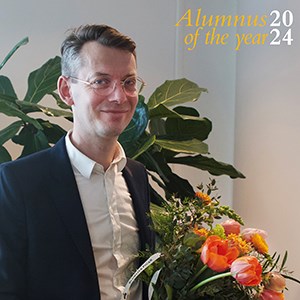Johan Folkesson, chief architect at Trafikverket (the Swedish Transport Administration) got his degree from SLU’s Landscape Architecture programme in 2015. In his role, Johan has designed and driven the importance of architecture and construction in transportation systems. Johan as a strong international engagement and contributes to SLU’s research and education. For these accomplishments, Johan has been named the SLU alumnus of the year 2024.
"I am completely honored and surprised, since my first day on the program I have seen the work with the relationship between people and landscape as a privilege. To receive an award like this from the university that gave me my knowledge base is really honoring", says Johan when SLU Alumni shows up at the Swedish Transport Administration's architectural meeting in Malmö.
Through his work, Johan has formulated the strategy of architecture for the Swedish Transport Administration, which aims to reach the goals for the policies in transportation, architecture, culture, as well as environmental and climate. The strategy covers a large part of the Swedish Transport Administration's activities: investigation, planning, location, construction and management of the state transportation infrastructure.
“The architecture of the road and railway can offer breathtaking views as we move through the landscape. But it's also about qualities on a smaller scale; a break while waiting for the next train or at a rest stop - then details and material become important and can enhance the experience.” Johan Folkesson (translation of a quote in Swedish).
As a chief architect and as a former board member of "Architects without Borders" as well as a member, international IFLA delegate and finally chairman of the "Swedish Academy of Landscape Architecture", Johan has run a large number of collaborative projects, seminars and debate articles to highlight society's physical challenges and landscape architecture's ability to contribute to a climate-adapted and designed living environment.
Johan is strongly committed to the Landscape Architecture program where he believes that students gain knowledge, tools and strategies to tackle many of the climate challenges the world is facing. How we design and plan our physical landscapes and cities has a crucial importance in how we achieve the climate policy goals. Through his commitment and network, he helps to strengthen international cooperation between SLU and other universities. He contributes with his knowledge both in research and in master courses. Johan also works to strengthen the link between practice and academia and pushes for a successful collaboration between the Swedish Transport Administration and SLU.
We took the opportunity to ask Johan a few questions.
In what way have you benefitted from your education at SLU in your work?
The Landscape architecture programme radically changed my perception of the surroundings. Landscape architecture is always present and I was trained to read the potential for change, enhancement or preservation in each place. An important contemporary task is to take care of the environments and buildings we have already built and here the knowledge from the course is central. Our landscapes are constantly changing and knowing which adjustments will lead to which future changes is invaluable knowledge - whether it is pruning an apple tree or landscaping a road.
Do you have any tips to young people who are interested in landscape architecture?
If you like to work in a creative profession where you have the opportunity to work with the relationship between landscape and sustainability challenges, the Landscape architecture program gives you a solid platform to stand on when the future seems more uncertain than ever. The education at SLU is world class, but take the opportunity to go on an international exchange. Staying in a new landscape can both give a new perspective on the education and broaden your view of architecture.
Listen to the experiences of others, but don't be dogmatic and never stop questioning the present - just like our mountain ranges, knowledge, working methods and legislation are constantly changing.
How do you work with sustainability in your role?
For the building and construction industry, a large part of the sustainability work is about taking care of what we already have. The Swedish Transport Administration's facilities are built with a technical lifespan of at least 120 years, but most buildings will remain in place for much longer than that. I therefore see questions about how we can meet future needs through operation, maintenance and wise reinvestment as a priority. At the same time, I see that virtually all aspects of the ongoing green transition are based on the landscape - but we lack a strategy for prioritization. Forestry and agricultural production, water and energy supply, mining, infrastructure and housing construction all relate to the sensitivity and potential of the specific landscape. I can conclude that our landscapes are becoming increasingly fragmented and that something needs to be done to strengthen the landscape perspective in Sweden, the Nordic region and globally.
Photographer: Ellen Hällebrand
